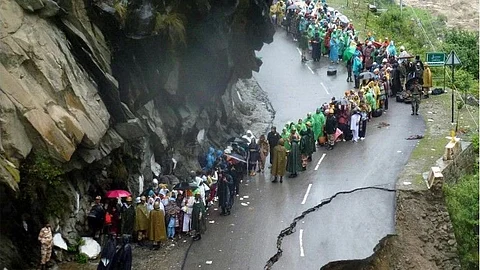
- Topics
- Feature
- Opportunities & Events
- About
- Hindi Portal
- Data
- Topics
- Feature
- Opportunities & Events
- About
- Hindi Portal
- Data

Given its geographic and climatic diversity, India is exposed to a variety of hazards that have forced its governments and communities to address risk, adapt to threats, and improve disaster resilience.
Over the last two decades, it has gained significant experience in the field of disaster management and has reorganized and improved its domestic capability. This was done after a succession of major disasters such as the super cyclone in Odisha (1999), Gujarat earthquake (2001), and the Indian Ocean tsunami (2004).
The aftermath of these devastating disasters led India to enact the Disaster Management Act in 2005, adopt the National Policy on Disaster Management in 2009, and develop the National Disaster Management Plan in 2016.
The Disaster Management Act helped to formalize and guide the development of disaster preparedness and response. This law led to the establishment of a national system of Disaster Management agencies headed by the NDMA.
Throughout this process, India consciously developed disaster management as a holistic approach, not just reacting after a disaster but also integrating disaster preparedness, mitigation, and disaster risk reduction (DRR) into plans and policies.
India has increasingly mitigated and responded to all types of disasters, including with the establishment of its National Disaster Reaction Force (NDRF), the world’s largest rapid reaction force dedicated to disaster response.
India has also delivered a substantial amount of foreign disaster relief and assistance to its neighbours by deploying its Armed Forces in response to a natural disaster apart from hosting and leading disaster response training and exercises.
India’s foreign humanitarian assistance has increasingly included its military assets, primarily deploying naval ships or aircraft to deliver relief. Many of the recipient countries have been in the region of South and Southeast Asia. The country has developed a specialized national disaster response force that plays a key role in saving lives at home and in the wider Indo-Pacific region.
However, historically, India’s MEA has shown a marked preference for working with other countries on a bilateral basis rather than through multilateral channels. For example, India’s NDRF was deployed to Japan and Nepal after earthquakes in 2011 and 2015 respectively, but these missions were agreed to and conducted on a bilateral basis rather than via international coordination groups like UN OCHA, the UNDAC system, or INSARAG.
More recently, NDRF has been working for INSARAG External Classification so that, rather than responding in a bilateral manner, it will be part of an international community of search and rescue teams with known qualifications and capabilities.
In recognition of the fact that India cannot operate unilaterally in the world and must establish membership, partnership, and even leadership in global bodies, the country has, in recent years, taken up more active roles.
Among this engagement, India is a stakeholder in the Sendai Framework for Disaster Risk Reduction, the Sustainable Development Goals (2015- 2030), and the Paris Agreement on Climate Change. Moreover, the country announced more significant commitments to addressing climate change in 2021.
The new approach was informed by the tenets that development cannot be sustainable unless disaster mitigation is built into the development process, that mitigation should be multi-disciplinary across all sectors of development, and that investments in mitigation are much more cost-effective than expenditure on relief and rehabilitation.
Within the context of the Bay of Bengal Initiative for Multi-Sectoral Technical and Economic Cooperation (BIMSTEC), India has hosted DM Exercises that allow NDRF to demonstrate for counterparts from partner states the techniques developed to respond to various disasters.
Other NDRF and Indian Armed Forces exercises have brought India’s first responders into contact with those from states in the South Asian Association for Regional Cooperation (SAARC) and the Shanghai Cooperation Organisation (SCO).
These efforts come as India, along with the rest of the world, is increasingly affected by climate change. Globally, disasters in the last two decades have predominantly been climate-related disasters, of which floods are the most frequently occurring type of disaster and storms are the second deadliest type of disaster (surpassed by earthquakes). India frequently experiences both floods and storms.
This handbook is intended to serve as an initial source of information for those individuals preparing for Disaster Risk Reduction activities or immediate deployment for a crisis alongside partner responders from India.
It highlights the important role India plays in preparing for, mitigating, responding to, and recovering from natural or man-made disasters in the Indo-Pacific region. It provides decision-makers, planners, responders, and Disaster Management practitioners greater insight into India’s Disaster Management capabilities, thereby enhancing regional civil-military response.
It discusses key areas such as India’s organizational structure for domestic and foreign disaster management, international Disaster Management agreements, regional training programs, and exercise support.
It offers a summary of the national social, political, and economic context within which India confronts disasters at home as part of an exploration of what types of hazards India most frequently experiences and, therefore, has specialized knowledge that can be shared with others. This handbook focuses on strengthening partnerships and is not an assessment of India’s capabilities.
It is part of a series that provides overviews of country and regional-specific factors that influence Disaster Management. As the world confronts unpredictable geophysical hazards and less predictable hydro-meteorological hazards within the context of global political and economic competition, Centre for Excellence-Disaster Management is committed to providing education, training, and research about Disaster Management and humanitarian assistance, particularly in international settings, which require coordination among military and civilian entities.
The handbook can be accessed here